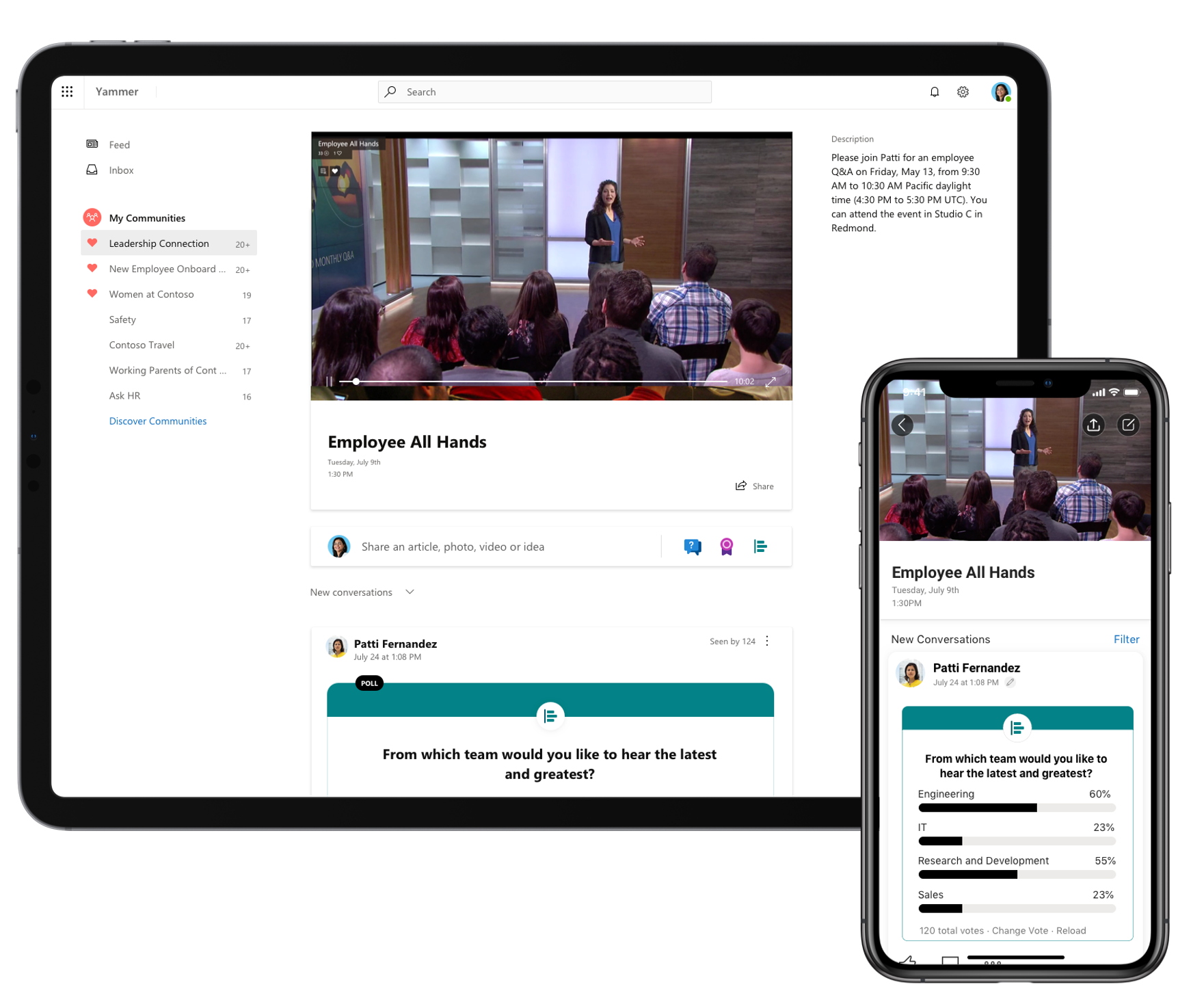What is Yammer?
Yammer is essentially a social networking tool for use within companies. Initially designed as a communication tool for a genealogy website, the platform was acquired by Microsoft in 2012 and reformatted to support enterprises. Yammer is designed to look and feel like other social networking sites you might use to communicate with your friends and family, such as Facebook and Twitter.
But unlike these sites, Yammer is fully integrated into the Microsoft 365 suite. Yammer feeds can be embedded into various points across your intranet, and Yammer share buttons make it easy to post engaging intranet content from anywhere within your digital workplace. Employees in Yammer groups can efficiently collaborate on shared Word, Excel, and PowerPoint files. Even Teams offers integration options with Yammer; you can now add a Yammer tab within a team and use various engagement-driven functions with the fairly new Yammer Communities app.
With Teams coming into the spotlight in 2020 due to its ability to facilitate remote work communication, Yammer seems to have taken a back seat. But even as Microsoft pours resources into improving Teams at lightspeed, it’s important to remember that Yammer still plays an important role in Microsoft 365. A digital communication strategy isn’t truly complete without incorporating elements of both Teams and Yammer.

Yammer vs Teams: Key Differences
Though Yammer and Teams have a shared end goal of facilitating communication, there are vast differences between the two platforms. Understanding these differences is key so that you can learn how to choose between Teams vs Yammer for various types of conversations.
Yammer facilitates larger group discussions
The primary difference between Yammer and Teams is the number of users who participate in discussions. Teams are limited to 10,000 users, although the overwhelming majority consists of just a handful. In Yammer, as many users as needed can join a group, extending the possibility to communicate across the entire company.
Microsoft refers to these two ecosystems as your inner loop and outer loop. Your inner loop consists of fellow team members and the people you work with regularly; these are the people you communicate with using Teams. On the other hand, your outer loop is made up of anyone in your organization with whom you might have shared interests or want to connect. Yammer is the best way to engage with your outer loop in more inclusive conversations.
Yammer enables discovery
Not only does Yammer allow more people to join conversations, but you also don’t necessarily need to invite them. When you create a public group, anyone in your company’s network can easily find it and participate. In contrast, teams and channels in Microsoft Teams are designed to be limited to a select number of people. Employees can only see content from users they’re already connected with, usual others in their team or office location. Yammer makes content discoverable and accessible, lifting the silos traditionally associated with communication in Teams.
Teams is designed for higher-velocity communication
Your conversations in Teams usually consist of rapid back-and-forth communication in high volume. With this in mind, a conversation you have in Teams may be buried in a matter of hours unless you bookmark messages to come back to later. Discussions in Yammer, however, often take place over the course of days or weeks as users browse the material at their own pace.
Since a message sent in Teams will notify recipients in a matter of seconds, the platform is ideal for urgent matters that need a fast response. But most posts made to Yammer won’t be seen right away, so users shouldn’t expect instant engagement with their content.
Teams has more integrations
Microsoft invested heavily in Teams in 2020, particularly driving integration between Teams and other apps in the Microsoft 365 suite. There isn’t much you can’t do from within Teams these days, whether it’s collaborating on a Word document or writing low-code apps like chatbots.
While Yammer has its own set of app integrations, they aren’t as functional as those available for Teams. Instead of facilitating tasks and workflows, they’re primarily designed to help distribute content and drive engagement across the organization.
Should I use Yammer or Teams? 5 scenarios to help you decide
So the question remains: where should you draw the line between Yammer vs Teams for group communication? Here are five common scenarios to use as a blueprint.
1. Collaborating on a group project: Teams
When it comes to collaboration, Teams is a clear choice. Project members can communicate within their own team or channel depending on the scale of the project and your company’s governance plan. Documents can be edited simultaneously by multiple contributors, exchanging messages in real-time or even jumping on a video call – all from right within the app. Since projects are typically limited to a defined number of participants, you’re unlikely to outgrow the Teams user capacity.
2. Collecting feedback on a company-wide initiative: Yammer
Gathering employee feedback is an essential part of any workplace initiative as it helps decision-makers make further improvements and gauge success. Yammer is the perfect place to create a poll or distribute a Microsoft Forms survey. It’s the most efficient way to reach the entire organization at once without having to overwhelm employees with notifications.

3. Discussing sensitive information: Teams
Sometimes certain company information needs to remain confidential among a group of employees. Discussions that involve sensitive details should only take place in private Teams channels where they can’t inadvertently stumble across other users. Although Yammer does allow users to set up private groups, they’re still easier to join through an invitation link or by administrator approval. It’s much easier to manage the privacy of information in Teams.
4. Asking for help with a workplace app: Yammer
Struggling to figure out how to use a feature in a workplace app? Asking for tips in Yammer is the best way to ensure that the call for help will reach as many eyes as possible. Many companies set up specific Yammer groups for different workplace technologies that act as a forum for all users across the organization. Even if a team member doesn’t have the answer, someone in another department may be able to share their knowledge to help solve the problem.
5. Introducing a new hire: Both!
As a general rule, it’s best to avoid duplicating information across Yammer and Teams, as this can lead to redundancy and confusion. But onboarding new employees is one exception where it may be appropriate to use both.
Introducing a new hire to their department via Teams is crucial in making sure the individual can begin forming relationships with the colleagues they’ll work with every day. In Yammer, however, there are further opportunities to make sure they feel welcomed. For example, you might consider creating a Yammer group for new hires across the entire company to ask questions and discuss the onboarding process.
Educating employees on the differences between Teams and Yammer and providing guidelines on when to use each communication tool is a great way to increase adoption rates across the organization. Powell Governance further drives adoption by making every Microsoft 365 tool more accessible and giving companies better control over governance. Schedule a demo today!




